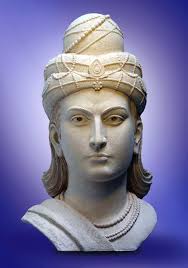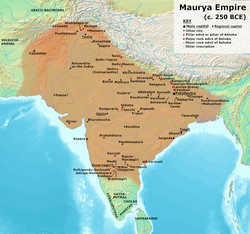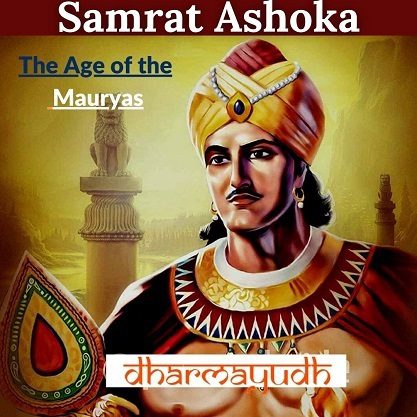The Mauryan Empire had a special place in the vast history of the Indian Sub-continent. They were the first ones who politically unified the country and took it to its greatest territorial extent.
Apart from this under the Mauryan rule, the sub-continent flourished in every field whether economy, trade, architecture, literature, etc.

“Ashoka The greatest of Kings”……H.G.Wells
The stories of the great Chanakya and Chandragupta and their struggle against the mighty Nanda Empire had fascinated historians and scholars.
In this article, we will cover the story of a Mauryan King who is known as the greatest King in Indian history. The man who stood for his ideals, principles, and virtue.
The king who’s early life had countless obstacles yet he never surrender and became the master of the subcontinent The Brave Samrat Ashoka.
Content
Early Life of Ashoka: Rise of A Samrat
Samrat Ashoka the Great was the son of Bindusara the second king of the Mauryan Empire. However, due lack of evidence we do not have enough information about the early life of this great monarch of the Mauryan Empire.
He is known by many names such as Devanampiya (beloved of the Gods), Piyadassi (pleasing appearance or good looks), etc.

Ashokavadana a Buddhist text gives us the name of Ashoka’s mother Subhadrangi who belonged to a Brahman family of Champa. Other Buddhist texts like Dipavamsa give us the name of Ashoka’s queens too. Karuvaki, Mahadevi, Asandhimitta were some of his queens.
Before becoming the king he was appointed as viceroy of Ujjain. At that time the city of Ujjain was known as the hub of trade and commerce as it connected the northern half of the empire to the west.
Later his father i.e. Bindusara sent him to suppress the rebellion in Taxila. This incident alone is sufficient that from a very young age Ashoka showed signs of excellent military leadership.
However Divyavadana a Buddhist text described his personality as a cruel and power-hungry king who seized the throne of the empire after brutally killing his 99 brothers.
But due to a lack of sources, we cannot conclude these claims. Furthermore, the various inscriptions of Ashoka had not mentioned this incident.
After the demise of Bindusara, there was a struggle for the throne of Magadha. It is believed that Bindusara appointed Susima as his successor but the nobles wanted to see Ashoka as their king. With the support of ministers like Radhagupta who later became the chief minister Ashoka continued this struggle.
Later he won this struggle after four years of tussling he declared himself Samrat.
Note: According to historians the actual date of Ashoka’s reign might have started from the year 273 BCE. From here a four years long struggle started in which various sons of Bindusara lost their lives. So the actual date of Ashoka’s coronation might be around 268-269 BCE.
Life as a King
After his succession, the emperor followed the footsteps of his grandfather i.e. Chandragupta Maurya, and started the policy of military conquest.
His empire subjugated the region from the mountains of Hindukush (including modern-day Afghanistan and Baluchistan) to the area of western Pakistan in the northwest.
Note: Samrat Ashoka was the first king who started to record his own conquests, ideals, and principles through inscriptions.
In the north, the region of Kashmir fell under his banner while in the south the region of Deccan including Malwa and Maharashtra became part of his dominion.
On the eastern side, Bengal and later Kalinga (The Kalinga War) also came under the sway of Ashoka. The region of the far south i.e. the kingdoms of Cheras, Cholas, and the Pandyas (kingdoms of Sangam Age) might have remained independent during this time.
The thirteenth rock edict of Ashoka tells us about his most extensive military campaign. The Kalinga War which took place around 261 BCE during the eighth/ninth year of his reign was a titanic encounter between the two powerhouses of ancient India.
Although the battle resulted in a victory for the Mauryas, but the horrors and the carnage of this war changed the heart of their emperor forever.
After this war, the Emperor accepted Buddhism as his religion and started to follow Dharma’s path (Dharma or Law of Piety).
Do you know how the story of Maharaja Kharavela the king of Kalinga who defeated the Magadha and took Kalinga’s revenge……. Hit the Link Maharaja Kharavela
Note: According to the Buddhist texts Ashoka was converted to Buddhism by a sage named Upagupta. According to the thirteenth rock edict of the Samrat Ashoka after the Kalinga war, the emperor felt remorse after seeing the sufferings of the war.
It is believed that the Samrat from the beginning of their career was influenced by Buddhism and the Kalinga war was the immediate cause for his conversion.
Although there are not enough sources that conclude that Ashoka immediately accepted Buddhism after the Kalinga war it is quite possible that the Mauryan king gradually accepted the new faith and not immediately after the battle.
Transformation of Emperor Ashoka: Law of Dharma
The emperor made the law of Dharma (Dhamma) the way of his life after the carnage of the Kalinga war. He also focused heavily to spread the ideal and virtue of his Dharma across the whole country and the world too.
His rock edicts and inscriptions also focus on the policies of Dharma. The main aim of his dharma was to generate tolerance, good behavior, moral ethics, etc, and his countrymen.
His rock edicts which tell about the policies of his Dharma focus on the prohibition of animal sacrifices, providing necessary medical help to every citizen, and showing benevolent behavior to every religion and monks (Both Brahman and Buddhists).
He also believed that respect should be given to elders and teachers (Gurus). He also organized the third Buddhist council under the leadership of Moggaliputta Tissa at Patliputra.
After this council, Emperor Ashoka sent several missionaries across the country for the propagation of Buddhism and Dharma.
Countries like Afghanistan, Srilanka, Syria, Greece, and the region of South East Asia received a lot of Buddhist missionaries from the Mauryan emperor.
Apart from all this Ashoka became an absolute follower of nonviolence and also replaced Royal Pleasure Trip i.e. (Vihara yatras) with Dharma Yatras (pilgrimage to holy places.).
During this time orders were given to protect the wildlife and several other animals which inhabit the forests. Dharamshalas and hospitals were made for the betterment of the people, something which the modern-day environmentalists and animal rights authorities failed to do so.
Rise of Indian Architecture
During Ashoka’s reign, the country flourished in the field of architecture. He erected Stupas, Viharas, and pillars in large numbers throughout the country.
He patronized various forms of architecture such as rock-cut, stone sculpture, terracotta figurines, and the stupa building.
It is believed that around 84000 Stupas were constructed all over the Indian subcontinent. Buddhist text Divyavadana describes his stupas as high as hilltops.
The magnificent rock-cut caves at Barabar and Nagarauna Hills are examples of brilliant Mauryan architecture.
Indian Government has adopted the Ashoka Chakra in the Indian National Flag while his Lion Capital (sculpture of four lions standing back to back) is the national emblem of India.
Samrat Ashoka to this day remained a glorious figure in Indian history. A monarch who united the Indian subcontinent under one rule, language, and Dharma. A king who was ambitious, benevolent, and courageous possessing the dauntless spirit of the Mauryan Empire.
Donate to our Cause
If you support what we are doing and would like to contribute to help us grow and reach more Indians to teach them more about such forgotten historic Indian Heroes and stories, please consider donating any amount. It will help us grow


Real Map of The Mighty Indian Maurya Empire is this :
Real Map of The Mighty Indian Maurya Empire